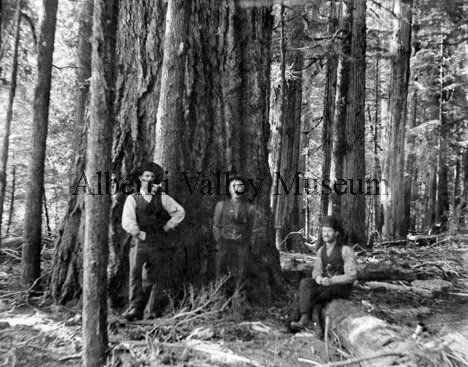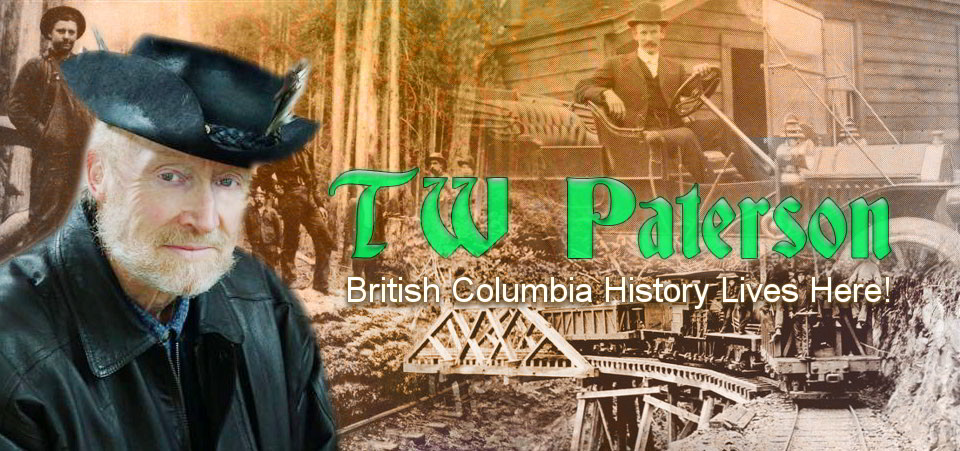Charles Taylor remembered Alberni’s colourful pioneers
“And a very interesting man he was, too,” the late Charles Taylor remembered, years ago.
He was referring to Robert Parkinson who appeared in the Alberni Valley in 1885 from London, Eng. A professional shoemarker, he settled beside the small bay which unofficially honours him.
Although it’s not formally listed as such in the B.C. Gazetteer, locals have long known the indentation on the west side of Alberni Harbour as Shoemaker Bay.
There has to be a story behind how a middle-aged man started life over again, a world away from home, in a cabin just 10 feet square.
Its only contents were a bunk, a table, a workbench and a converted oil drum for a stove-heater.
Whatever was Parkinson’s past, he kept it to himself.

Alberni pioneers, identities unknown. —www.pinterest.com
His needs were few; dinner was either salmon he caught himself or a duck shot from his front doorstep, game being plentiful then. He made and sold boots that were so strong and durable—every stitch was hand-sewn, the soles heavily hobnailed—that some outlived him.
His standard price, materials included, was $5 a pair. Even allowing for the fact that $5 was worth more, in those days, after deducting the cost of leather and his hours of careful labour, his profit must have been quite slim.
Despite his out-of-the-way location, at the end of a blazed trail, his craftsmanship and his reasonable prices drew a steady clientele, and he managed to get by.
When he went to town, it was a major undertaking. As there was no bridge, getting to the store and post office on the other side of the river posed a problem. But his resourcefulness didn’t fail him here. At high tide, he’d paddle his canoe to a slough the extended across salt-flats until near the river. He’d then load a small wheelbarrow, which he kept cached for this very purpose, into his canoe and continue on to the head of the slough.
There, he’d reverse the procedure. With the canoe in the wheelbarrow, he’d cross the small isthmus on the river, swap canoe for barrow, and complete his journey. Returning home, of course, meant the same cumbersome routine in reverse.
“He seemed to have no relatives,” Mr. Taylor recalled in 1964 during one of my first-ever interviews as a writer, “and left a little money to a lady who had looked after him in his final illness. The balance, which amounted to a few hundred dollars, was left to the Anglican Church.
“He stipulated that his home was to be used by any destitute, deserving man. It [all 100 square feet of it!] served as an old man’s home for 50 years. They called it the Anchorage. I think it was torn down only two or three years ago…”
Another fascinating Alberni pioneer Mr. Taylor recalled was former Kootenay miner and craftsman Nils Weiner who made his home beside Sproat Lake at Brannan’s Bay, now Weiner Bay (another of those geographical features which have escaped the B.C. Gazetteer‘s notice).
An industrious, all-round handyman, he built a strong, comfortable home and cleared a few acres. But, just two or three years later, his wife died, and “things were never the same for Nils after that”.
Upon the outbreak of the First World War, and a resulting wave of patriotism, Weiner found himself among those citizens originally from Germany and Austria whose loyalty to Canada was suddenly placed in doubt. Weiner, in fact, was Swedish, but many took him to be Prussian, as Jan Peterson (“Peterson, Jan, 1937-“) noted in her history of the Albernis, 1860-1922.
This xenophobia cost at least one longtime Alberni resident his citizenship; presumably Weiner was able to satisfy any doubts as to his past origins and present loyalties.
He remarried but this partnership ended in separation. Weiner lived alone after that, keeping to himself. A fine boat builder, mechanic and woodcarver, he supplemented his income by carving rifle stocks, fly-rods, fancy wooden spoons and such items. His hand-crafted violins became collectors’ items.
Particularly so after the night that “several residents around the lake were disturbed by loud explosions in the vicinity of the Weiner place. Next morning, upon investigation, they found his home had been blown to pieces, and all the outbuildings were burned to the ground.
“Although they even searched an old well on the place, nothing ever was seen of Weiner again, and many believe he blew himself up with the house.”

Dear Mr Paterson
I read your 2017 article about interviewing Lusitania survivor Florence Padley. I was wondering if you had found the tape & had it transferred.
Sincerely
Michael Poirier
RMS Lusitania Association of Relatives
I’m sorry to say that I haven’t. Coincidentally, however, I’ve reached a point in life that I’m actively trying to get my affairs–my archives, my library, my files, etc. etc. etc.–in a real semblance of order. It has taken me half a lifetime to create what is now a monumental task. The tape of Florence Padley is a perfect example of the type of “loose ends” I’m trying to deal with. Your query is a reminder to me how important my tapes are for posterity. I’ll discuss it tomorrow with the lady who is helping to do all this. I shall file your query as a reminder to dig out my tapes. I shall inform you if and when I can make some progress in this regard. –TWP
. Thank you so much. I appreciate it